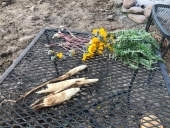Alicia Metz wrote: The reason I'm going with raised beds is to protect against gophers.
We recently moved from northern California and gophers are not my favorite animals. I tried cinder-block raised beds stacked two high - so that was 16 inches in height I think. They got in by digging under the blocks.
The next season we dug up the bed and laid 1/2 x 1 inch hardware cloth down, then put the bed back in.
It worked for a year, but then they were back. Later on, we re-dug that bed again and found a slight separation between two layers of hardware cloth that didn't overlap enough and had been enlarged (with teeth) to become a two inch hole the gophers could use as a doorway. And they did.
I gave up on that area and went largely to container gardening even though we lived on a full acre. Cinder blocks worked great otherwise -- though I've read the newer ones are from China and may include some toxic materials that aren't allowed in the USA sourced blocks. Can't say for sure. Might be worth checking around for used cinderblocks that are a few years old though, just in case. If you want to minimize cost, try a U-shaped raised garden bed. You can harvest more easily too.
Just re-read your more recent post. Strongly recommend against poultry wire. Even with the 1x1 tighter type, the gophers will get through. 1/2 x 1 inch hardware cloth (galvanized!) would be the minimum - otherwise that's a lot of work to re-do.
Good luck with everything.



